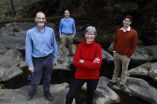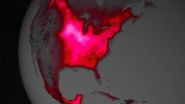(Press-News.org) In the summer of 2009, Stanford Professor Chris Field embarked on a task of urgent global importance.
Field had been tapped to assemble hundreds of climate scientists to dig through 12,000 scientific papers concerning the current impacts of climate change and its causes.
The team, Working Group II, would ultimately produce a 2,000-page report as part of a massive, three-part U.N. Intergovernmental Panel on Climate Change (IPCC) Fifth Assessment Report, which details a consensus view on the current state and fate of the world's climate.
The job would take nearly five years, spanning time zones and languages, and requiring patient international diplomacy, dogged organizational discipline and a few napkin doodles. Marathon debates conducted over Skype crashed the service more than once.
"It's got lots of moving pieces, personalities and opportunities for things to go right or wrong," said Field, who co-chaired the effort. "You end up with a report that reflects the balance of understanding across the scientific community."
In addition to being a professor of biology and of environmental Earth system science, he heads the Department of Global Ecology at the Carnegie Institution for Science, and is a senior fellow at the Stanford Woods Institute for the Environment and the Precourt Institute for Energy.
This team conducted most of the work behind closed doors, but Field and other Stanford faculty members who played key roles shared a behind-the-scenes story of what it takes to generate the most comprehensive diagnosis of the health of the planet and the risks it faces.
Beginning the journey
For Field's group, the long road began in earnest at a July 2009 meeting in Venice, Italy, where 209 scientific experts and IPCC members from around the world developed a chapter-by-chapter outline of the report. Their outline was later formally accepted at a meeting in Bali, Indonesia.
But before Field and his team could begin the heavy lifting of writing the report, they hosted a kind of American Idol-style search for scientists to serve as authors and editors.
Over several months, they sifted through 1,217 nominations representing 73 countries. Field's team read every nominee's resume and consulted with observer organizations and senior climate science leaders on each. "There's a full diversity of opinions," Field said, pointing out that some of those selected are outspokenly skeptical of computer climate modeling, for instance.
After participants from all IPCC countries vetted the final selections, the 310 new colleagues – including a number of Stanford researchers – were ready.
Putting the pieces together
Much of the work was done at night or on weekends. Among the authors and editors staying up late were Stanford Woods Institute Senior Fellows Terry Root, a professor, by courtesy, of biology, and David Lobell and Noah Diffenbaugh, both associate professors of environmental Earth system science. "There is no institution as richly represented as Stanford," Field said.
Stanford even hosted a U.S. government-funded office on campus, with five scientists and four technical staffers. The university also provided library research privileges for IPCC authors from developing countries.
"Stanford didn't see it as a distraction, but as a fundamental function of the university," Diffenbaugh said. His 9-year-old daughter, however, had a different perspective. Her father, worn out from after-hours work on the assessment, would often fall asleep while reading bedtime stories.
"There were definitely a lot of late nights," Diffenbaugh said. "You want to know the answer, and you want to get it right. In that sense, it's not a punch-the-clock kind of activity." Authors were told during orientation that they should expect to devote about 25 percent of their time for three years to the report.
"Overall, it's a process designed to not let any nonsense through, so that policymakers get only the best of what science can say," said Lobell, a lead author on a chapter about food production systems and food security. "That takes a lot of checking, rechecking and outside review, which is not always the most exciting, but you do it realizing that it's part of the process."
Sometimes, it took pen sketches too. Lobell recalled a group effort to come up with a key summary figure for the chapter he worked on about food security. "We ended up doodling on napkins over dinner, and then I went back and made a version that ended up in the final report. One of the senior authors described that as the highlight of his career."
Reaching consensus
The journey to the final draft was a delicate exercise in international relations.
"It is a tough job," said Root, a review editor for a chapter on terrestrial and inland water systems. "You must be very current with the literature, and due to space constraints there are always 'battles' to include what each author thinks is important. It is wonderful, though, getting the opportunity to work with the best scientists around the world."
Root and her fellow chapter editors in Spain and Switzerland would hash out their different perspectives during early-morning conference calls. Their Skype sessions sometimes went for more than four hours.
The chapter teams pored over dozens of peer-reviewed studies, some of them from nonscientific journals, discussed and debated findings, and then settled on language they were all comfortable using. "Instead of telling your fellow scientists they were full of it, you just had to say, 'Where's the traceable evidence?' and they would change their tune," Lobell said. Still, "there was nearly always a friendly atmosphere."
"The challenge is also to communicate things clearly," he added. "For example, it doesn't help much to say, 'Things are uncertain.' It's better to say something like, 'If we knew A, we would know B, but we don't really know A.'"
With consensus on their minds, representatives of IPCC member countries met in Switzerland in late February to review the report's final draft.
"If the countries don't agree on particular text, generally the text doesn't get in there," Field said. In some cases, representatives from a small group of countries might decamp to a separate room to work out differences of opinion. "For the exceptionally rare cases where every country but one agrees on something, sometimes text will go into the report saying every country but one agrees on this."
The homestretch and beyond
Leaders in business, national security, public health, agriculture and other fields can make good use of the data, said Michael Mastrandrea, a Stanford Woods Institute consulting assistant professor. "Climate change is not just something for governments to be thinking about."
Field acknowledged that the report's continued value depends on making it more accessible and relevant to a wider audience. "There are a number of things I think the IPCC does spectacularly well. There are some things we don't do so well," he said. Field would like to see more author participation from the private sector, such as oil companies and reinsurance firms, and more integration of IPCC working groups.
Perhaps most important, Field envisions providing more user-friendly, customizable and interactive electronic data on an ongoing basis, as opposed to one massive report every six or seven years.
The report will serve as a foundation for international negotiations at events such as the U.N. Climate Leaders Summit scheduled for September. U.N. Secretary General Ban Ki-moon has called on world leaders to make "bold" pledges at the meeting and to demonstrate they will achieve ambitious emissions cuts as part of a legal agreement to be signed in early 2015. Field remains optimistic that the report can spur policy and technology that will steer the Earth toward a more sustainable future.
"Even though we face some serious challenges, we have some really attractive opportunities for building a better world in the future," Field said. "The thing we need to wrap our collective brains around is that building a better world is going to require taking advantage of the scientific knowledge and being smart about managing the risk."
INFORMATION: END
Behind the scenes of the IPCC report, with Stanford scientists
2014-03-31
ELSE PRESS RELEASES FROM THIS DATE:
USC Viterbi researchers developing cheap, better-performing lithium-ion batteries
2014-03-31
Researchers at the USC Viterbi School of Engineering have improved the performance and capacity of lithium batteries by developing better-performing, cheaper materials for use in anodes and cathodes (negative and positive electrodes, respectively).
Lithium-ion batteries are a popular type of rechargeable battery commonly found in portable electronics and electric or hybrid cars. Traditionally, lithium-ion batteries contain a graphite anode, but silicon has recently emerged as a promising anode substitute because it is the second most abundant element on earth and has ...
New non-surgical treatment for common, vexing eye condition
2014-03-31
Baltimore, MD, 31 March 2014. – A new report reveals a potential breakthrough in the treatment of a common eye ailment known as pterygium (Surfer's eye) that impacts the vision, eye health, and cosmetic appearance of countless sufferers.
The newly published report shows that eye drops containing the anti-anginal drug dipyridamole (Persantin®, Cardoxin®) led to almost total disappearance of an inflamed pterygium in a 35 year old otherwise healthy woman.
Dipyridamole is a drug in use over the past 55 years to treat other disorders, but now found to have this remarkable ...
Lowering your cholesterol may improve your sex life
2014-03-31
A new Rutgers study is giving hope to older men concerned about the effects of cholesterol-lowering medications on their sexual health.
The research, conducted at Rutgers Robert Wood Johnson Medical School, found that statin medication prescribed to lower cholesterol and decrease the chance of heart attack and stroke, also improves a man's erectile function. The researchers reported their findings at the American College of Cardiology's annual scientific session in Washington DC March 29 and in the April issue of The Journal of Sexual Medicine.
"Older men who have poor ...
Genetic cause of heart valve defects
2014-03-31
Heart valve defects are a common cause of death in newborns. Scientists at the University of Bonn and the caesar research center have discovered "Creld1" is a key gene for the development of heart valves in mice. The researchers were able to show that a similar Creld1 gene found in humans functions via the same signaling pathway as in the mouse. This discovery is an important step forward in the molecular understanding of the pathogenesis of heart valve defects. The findings have been published in the journal "Developmental Cell".
Atrioventricular septal defect (AVSD) ...
Satellite shows high productivity from US corn belt
2014-03-31
Data from satellite sensors show that during the Northern Hemisphere's growing season, the Midwest region of the United States boasts more photosynthetic activity than any other spot on Earth, according to NASA and university scientists.
Healthy plants convert light to energy via photosynthesis, but chlorophyll also emits a fraction of absorbed light as fluorescent glow that is invisible to the naked eye. The magnitude of the glow is an excellent indicator of the amount of photosynthesis, or gross productivity, of plants in a given region.
Research in 2013 led by Joanna ...
Nearly 97 percent of health professionals wash their hands when patients are asked to watch: Study
2014-03-31
TORONTO, ON, March 31, 2014 --
Improving hand hygiene compliance by healthcare professionals is no easy task, but a first-of-its-kind Canadian study by researchers at Women's College Hospital shows simply asking patients to audit their healthcare professional is yielding high marks.
The study, published in the April edition of the American Journal of Infection Control, details the findings of an 11-month pilot project looking at an alternative method of hand hygiene auditing using the patient-as-observer approach. In this method, patients observe and record hand hygiene ...
Rural versus urban causes of childhood concussion
2014-03-31
Researchers at Western University (London, Canada) have found youth living in rural areas are more likely to sustain concussions from injuries involving motorized vehicles such as all-terrain vehicles and dirt bikes, whereas youth living in urban areas suffer concussions mostly as a result of sports. Hockey accounts for 40 per cent of those injuries. The study which reveals where and how children are receiving concussions is published in the Journal of Trauma and Acute Care Surgery.
Dr. Doug Fraser, a scientist with the Children's Health Research Institute at Lawson ...
Proteins discovered in gonorrhea may offer new approach to treatment
2014-03-31
CORVALLIS, Ore. – Researchers at Oregon State University have discovered novel proteins in, or on the surface of the bacteria that causes gonorrhea, which offer a promising new avenue of attack against a venereal disease that is showing increased resistance to the antibiotics used to treat it.
Only a single, third-generation cephalosporin antibiotic still shows good efficacy against gonorrhea, creating a race against time to find some alternative way to treat this disease that can have serious health effects. It's the second most commonly reported infectious disease in ...
Where to get Viagra news? (Really, this isn't spam)
2014-03-31
RIVERSIDE, Calif. — Do you want information on Viagra or ibuprofen? Check out general social networks such as Twitter and Pinterest. Interested in sleep disorders or depression? You're better off going to specialized health social networks such as WebMD or drugs.com.
That is one of the findings of a just published paper, "Pharmaceutical Drugs Chatter on Online Social Networks," based on an analysis of more than 1 million drug-related posts, by a team of researchers at the University of California, Riverside's Bourns College of Engineering and Zhejiang University in China.
The ...
Biolimus still comparable to everolimus in year 2 of stent match-up
2014-03-31
WASHINGTON (March 31, 2014) — A new stent covered with biodegradable coating continues to show statistical equivalence to Japan's market leader in cumulative second-year data and subgroup analyses, according to research from the NEXT trial presented at the American College of Cardiology's 63rd Annual Scientific Session. NEXT is the largest head-to-head randomized study of these two stents – the novel biolimus-releasing model with the degradable coating (BES) and the everolimus-releasing standard with a durable polymer (EES).
Polymer coatings contain the drugs in drug-eluting ...




